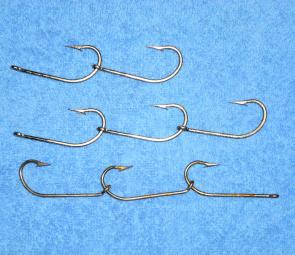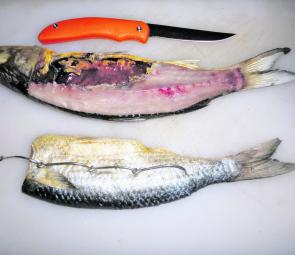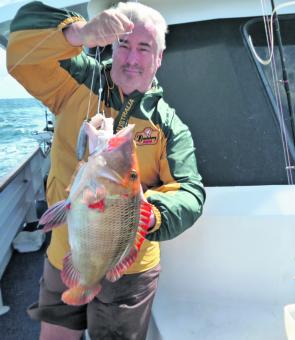In this final instalment of the paternoster back to basics, it is time to take a look at when and why to use more than one hook on the dropper.
I like ganging hooks for two main reasons:
Firstly, a three hook gang of 7/0s embedded in either a strip bait or whole fillet of fish flesh (including tail) makes a great Spanish mackerel bait. The mackerel (or big red emperor or coral trout) gets presented with a big bait – big bait means big fish! The big fish’s razor sharp teeth get to gnaw on one of the hooks in the gang. The hooks act as a wire trace and distance the mack’s teeth from the mono line, which they’ll normally bite through in one clench of their interlocking shredders.
Secondly, a gang of two 5/0 7766D Mustad Tarpons can be used to present a big bait on a smaller hook. The top hook holds the strip of flesh along the length of the bottom hook with a reduced risk that the bait will bunch up in the gape of the bottom hook, which is one of the reasons why hooks fail to fully penetrate. Then, the fish that you are reeling in falls off the hook half way up as soon as you give the line a momentary lapse into slackness.
I’m partial to bait sizes that suit two hook gangs when targeting medium-sized reefies, such as coral trout and sweetlip. I have experienced a few times, that triple-hook gangs have a tendency to get bunched up in the mouth of smaller reef fish (like small snapper). When these three hook ganged strip baits get folded over they hook into themselves. This tangle prohibits any of the hook points from digging in and getting a good enough purchase on your prospective dinner.
Notwithstanding this, there are uses for three hook gangs but mainly for bigger fish and I’m thinking specifically mackerel scenarios as mentioned already.
A single front hook with either a treble or single hook ‘as a stinger’ to put in the back of a bait is a good option when live baiting. This stinger option is ideal for use on a single dropper rig with live slimies, yakkas or non-coral reef fin fish (coral reef fin fish can't be kept alive by law), non-regulated fish, such as stout whiting, and legal species over their minimum length limit.
If there are mackerel patrolling the bottom, then our stinger rigs (pre-tied) are tied from nylon-coated seven stranded type cable wire. Spaniards can bite through light cable wire so we go 70-135lb (seldom greater) or we use single strand wire.
An alternative to a stinger treble hook is to use a simple gang rig and put a flight of hooks along the top of a fish’s back. This has those ‘mackerel teeth avoiding’ benefits that I mentioned earlier.
Pilchards can be rigged on three ganged Mustad 7766 Tarpons of 5/0 size; or half pillies on two 5/0s ganged. Half pillies can also be rigged on single red ‘chemical’ Tarpons.
I’ve used Mustads in the 4200 series and 7766 series for over 25 years. I stick with what works.
Most anglers like to place the hooks of the gang through the upper back of the pillies because they hold on better than if the hooks go into the stomach section.
As a very basic rule, the drill is to measure the gang along the length of the pilchard and note, not where the hook points are but, the bottom end of each gape curve. Then begin rigging the bait by putting the bottom hook’s (last hook) point through close to where the tail hook’s gape was when you laid the gang along the bait.
With the tail hook in place you can then place each hook point successively through the bait until you get the top hook, which is passed through the head or eye of the pilchard.
Rigging a strip bait on a gang rig is done in a similar way – the secret to success is to have the top hook in place with about a centimetre of fish flesh above it. That way it won’t pull out too easily. This keeps the bait flat on the hooks and also there isn’t too much flesh above the top hook that its gape will fill up.
Another trick, if you are using a two-hook gang to comply with IGFA regulations, is to have a small piece of copper wire fashioned to the eye of the top hook. This allows you to place the hooks down along the bait and to then tie the wire off through/around the front eye (and to tie the pilchard’s mouth closed). This is sort of just like you’d do with a wire spring on a dead troll bait. This trick also works well when hiding single hooks inside a pilchard bait.
A lot of anglers like to use pilchards on the top dropper of a two hook dropper rig when fishing at anchor because the pillies act as berley. Many times the fish that you do catch will have their stomach full of pilchard pieces. This pretty much proves to me that the berley strategy is really successful in not only attracting passing fish but also in keeping them around.
Freshly caught strip baits, such as cut up non-regulated reefies like iodine bream, fusiliers or yakkas, or thawed strip baits from mullet, squid or mac tuna are best presented on two 5/0s ganged. The two-hook gang holds the bait as a tantalising wafting strip without it bunching up in the hook gape.
The larger whole slimy mackerel work best on a triple gang of 6/0 or 7/0.
By Queensland regulations the definition of ‘a hook’ includes a ganged hook set of up to six adjoined hooks. Therefore, you are allowed to use up to six hooks in a gang.
Another bait that I use three hook gangs in, is what I know as a tail bait. A tail bait is a whole fillet, like from a small mullet. You take the entire fillet off the baitfish, including the tail, ensuring that the bone at the gill end of the fillet is left attached securely to the fillet.
The gang is laid alongside the bait so that the top hook ‘locks’ around that curved bone. This produces a very secure bait, with a tail to waft around and attract the big fish without too much flesh away from the hooks for pickers to chew on.
I normally place this bait on the hooks skin-side first.
If the strip of bait has any thickness to its flesh then I prefer to rig it on the hooks, so that the hook points come out on the flesh side of the bait.
In other words, put the strip bait on the hooks skin-side first. This reduces the risk that, after rigging, a scale could be dislodged by a hook point and impede the hook point from going into your target species.
If the bait is thin fleshed, with small scales and the hook gapes are large enough then I’m less concerned. However, if the bait comes from a fish with large scales (especially with the scales still on) then this fine detail becomes even more important.
The bottom three hook 5/0 gang (facing the other way) made from 4202D hooks is an ideal ‘entry-level‘ gang rig for using with whole pilchards as bait. Limit the use of these non-forged wire hooks to a maximum of 30lb mono type mainline. The angled eye on the hooks allow them to slide along each other more freely.
An alternative with this rig (especially in fast flowing water) is to use the straight eye 4200 as a top hook.
The stouter 6/0 Tarpon hooks represented by the two-hook and three-hook gangs above I’ll use with 50lb braid as the mainline. I use 7/0s and larger from the 7766 Tarpon range when using 65lb and 80lb braid. We may rig whole baits (pilchards or slimies or squid for example) and/or strip baits on either of these set-ups.
I’ve flipped the bait fillet over in this photo so that you can see the very important placement of the top hook around the bone. Using a pair of scissors, you may wish to trim (fin clip) the pectoral fin from the bait.
Reads: 11730
Typical ganging options:

This flight of gang hooks won the battle with a big Spanish mackerel. The Spaniard was hooked on the top hook and the line was 50lb braid pushed to the max. Hence the half-straightening of the Mustad Tarpon. Hook designers face the dilemma – should they m

Lay the hooks down the bait before you fillet it. If you buy bait make sure they have not had their ‘gut’ removed. Baits that have had the gut removed only offer one full strip with the pectoral bone intact. This is because a cut is made on one side of th

A mullet strip on a four-hook 7/0 gang rig – aka long tailed strip bait or tail bait. This is a big bait for a big fish – think red emperor and largemouth nannygai. You need a sharp knife to split the tail, and a little practice.


Trevor with a red throat emperor; the hooks are a two hook gang and the bait a long strip of iodine bream. Fully distended mouths can engulf quite large offerings.

Bill with a red throat emperor caught on two-hook gang.




